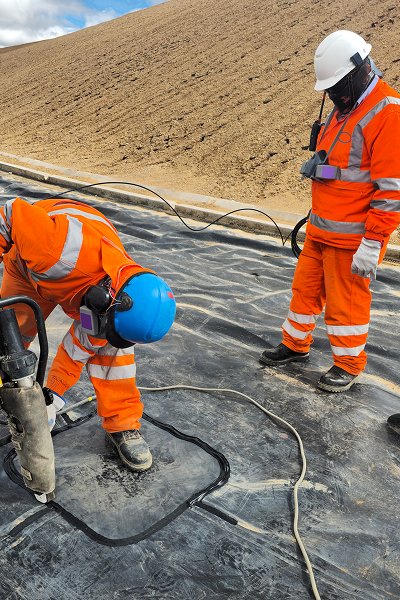-

09 December - 2025
IndustryPP geotextile bags vs. PET geotextile bags: How to choose?Geobags are used in river management, coastal protection, dam reinforcement, landscape engineering, and silt consolidation.
View More
-

26 November - 2025
IndustryWhy are road reinforcement costs so high? How can geocells save 30%?Road reinforcement costs remain high? How can HDPE geocells reduce roadbed reinforcement costs by 20-30% while significantly improving load-bearing capacity and construction efficiency?
View More
-

21 November - 2025
IndustryGeotube filling construction processDetailed Explanation of Geotube Filling Construction Process: From site preparation, layout, fixing, filling, dewatering to shaping, including safety points, quality control methods, and answers to frequently asked questions. Applicable to coastal protection, river dredging, solidification and dewatering, and silt treatment projects.
View More
-

19 November - 2025
IndustryWhy Landfills Must Use 1.5mm / 2.0mm HDPE Geomembrane?1.5mm/2.0mm HDPE geomembrane is a mandatory requirement for landfill seepage prevention systems. This article analyzes the reasons for thickness selection, standards and regulations, permeability coefficient, construction requirements, and service life, providing the most authoritative reference for engineering design and procurement.
View More
-

13 November - 2025
IndustryApplication of GCL (Geosynthetic Clay Liner) in seepage control projectsGCL composite impermeable materials are typically made of two layers of geotextile (or one layer of fabric and one layer of membrane) encapsulating sodium-based bentonite particles. Their impermeability depends on the low-permeability gel layer formed when the bentonite swells upon contact with water.
View More
-

08 November - 2025
IndustryPolyester Geogrid: The Key Role of High-Strength Reinforcing Materials in Road and Slope StabilizationPolyester geogrid is a commonly used reinforcing material in engineering projects such as roads, railways, slopes, and retaining walls, due to its high tensile strength, low elongation, excellent creep properties, and good chemical stability.
View More
-

06 November - 2025
IndustryGeotubes: A new generation of environmentally friendly solutions for efficient dehydration and protection.A geotube is a large, tubular dewatering container made of high-strength woven geotextile. It works by pumping high-moisture slurry or tailings into the tube, utilizing gravity and filtration to remove water while retaining solids.
View More
-

31 October - 2025
IndustrySelection of geomembrane thicknesses: 0.5mm, 1.0mm, and 2.0mmThe performance, standards, and application scenarios of HDPE geomembranes of different thicknesses help you scientifically select 0.5mm, 1.0mm, or 2.0mm geomembranes to ensure project safety and economy.
View More
-

22 October - 2025
IndustryWhy can geocell honeycomb structure greatly improve bearing capacity?Geocell quickly improves the bearing capacity of weak foundations (suitable for airport runways, temporary roads, factory sites, etc.)
View More
-

20 October - 2025
IndustryHow much does non-woven geotextile cost per square meter? 5 factors that affect the priceNon-woven geotextiles are geosynthetics made from polypropylene (PP) or polyester (PET) fibers through needle punching or hot rolling. They have excellent water permeability and mechanical strength. They are not woven into a structural form.
View More
-

13 October - 2025
IndustryFive factors affecting the dehydration efficiency of geotubeThe factors that affect the dewatering efficiency of geotubes are systematic, including material selection and structural design, as well as filling mud properties, flocculant ratio, on-site construction environment and other conditions. Only by understanding these factors can the efficient operation, energy-saving dewatering and structural safety of geotube systems be achieved.
View More
-

08 October - 2025
IndustryHow to design a Geotube with appropriate size and volume?Geotubes, as an efficient, economical, and environmentally friendly solid-liquid separation and protection material, are increasingly being used in engineering fields such as dredging and dewatering, coastal protection, land reclamation, sludge treatment, and flood control dams. They use specially made high-strength geotextiles to encapsulate water-containing solid materials such as mud or sludge, and utilize the permeability of the filter fabric to achieve dehydration and solidification, thereby converting the fluid into a stackable and reusable solid material.
View More

get in touch

Lets Talk!












